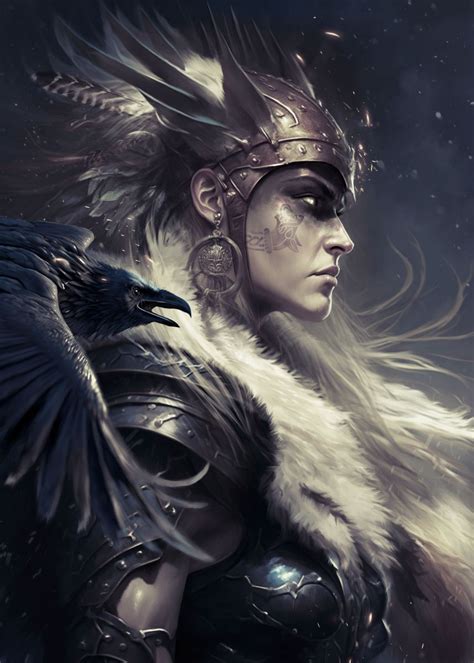The realm of Norse mythology is rich in legends and characters that have captivated the imagination of people for centuries. Among these, the Valkyries stand out as enigmatic and powerful beings, tasked with the solemn duty of choosing which warriors would die in battle and ascend to the afterlife of Valhalla. The name "Valkyrie" itself is derived from the Old Norse "Valkyrja," meaning "chooser of the slain." This etymology not only reflects their primary role but also underscores their importance in the Norse cosmology.
The Mythological Context of Valkyries

In the vast expanse of Norse mythology, the Valkyries are depicted as female figures, often associated with war and fate. Their origins are shrouded in mystery, but they are generally believed to be the daughters of gods or sometimes even goddesses themselves. The most famous account of Valkyries can be found in the Poetic Edda and the Prose Edda, medieval Icelandic manuscripts that preserve much of what we know about Norse mythology today. These texts describe the Valkyries as being capable of taking on various forms, including that of swans, which symbolize their connection to both the natural world and the supernatural.
The Role of Valkyries in Battle and the Afterlife
The primary role of the Valkyries was to decide the outcome of battles, selecting half of those who would die to join the gods in Valhalla, while the other half would go to the goddess Freyja’s afterlife field, Folkvangr. This selective process not only determined the fate of warriors but also influenced the balance of power among the gods, as the strength of the armies in Valhalla was crucial in the events leading up to Ragnarök, the Norse apocalypse. The Valkyries would often intervene in battles, sometimes directly influencing the outcome by either protecting certain warriors or marking them for death.
One of the most intriguing aspects of the Valkyries is their ability to move between the mortal world and the realm of the gods with ease, carrying out their duties with a blend of ferocity and grace. Their connection to the warrior culture of the Norse people is deep, reflecting the societal values of courage, honor, and the pursuit of glory in battle. The selection process by the Valkyries was not arbitrary; it was based on the valor and prowess of the warriors, ensuring that only the most worthy would be granted a place among the gods.
| Aspect of Valkyries | Description |
|---|---|
| Origins | Often depicted as daughters of gods or goddesses |
| Forms | Can take on various forms, including that of swans |
| Role in Battle | Decide the outcome of battles, selecting warriors for Valhalla or Folkvangr |
| Connection to Afterlife | Determine the fate of warriors, influencing the balance of power among gods |

Key Points
- The Valkyries are central figures in Norse mythology, tasked with choosing which warriors would die in battle and ascend to Valhalla.
- Their origins are rooted in mystery, with various accounts depicting them as daughters of gods or goddesses.
- The Valkyries can take on multiple forms, including that of swans, symbolizing their connection to nature and the supernatural.
- The Valkyries' actions have significant implications for the balance of power among the gods, particularly in the lead-up to Ragnarök.
The Evolution of Valkyrie Legends

Over time, the legends of the Valkyries have evolved, influenced by various cultural and literary interpretations. From their depiction in medieval Icelandic texts to their modern representations in art, literature, and popular culture, the Valkyries have remained fascinating figures, embodying both the beauty and the brutality of war. Their mythological significance extends beyond the Norse pantheon, speaking to broader themes of mortality, honor, and the human condition.
Valkyries in Modern Culture
In contemporary society, the Valkyries have become symbols of female empowerment, strength, and independence. Their depiction in popular media, such as in films, video games, and comic books, often draws on their mythological roots while introducing new interpretations and adaptations. This evolution not only reflects the changing values and interests of society but also underscores the enduring appeal of the Valkyries as cultural icons.
The study of Valkyries and their role in Norse mythology offers a unique lens through which to explore the beliefs, values, and practices of ancient Scandinavian societies. By examining the myths, legends, and historical contexts surrounding these figures, scholars and enthusiasts alike can gain a deeper understanding of the complex and multifaceted nature of human culture and imagination.
What is the primary role of Valkyries in Norse mythology?
+The primary role of the Valkyries is to choose which warriors would die in battle and ascend to the afterlife of Valhalla or Folkvangr, based on their valor and prowess.
Can Valkyries take on different forms?
+Yes, according to Norse mythology, Valkyries can take on various forms, including that of swans, which symbolizes their connection to nature and the supernatural.
What is the significance of the Valkyries in modern culture?
+The Valkyries have become symbols of female empowerment, strength, and independence in modern culture, with their depiction in popular media drawing on their mythological roots while introducing new interpretations and adaptations.
In conclusion, the Valkyries of Norse mythology represent a fascinating blend of mythology, culture, and symbolism, offering insights into the values and beliefs of ancient Scandinavian societies. Their enduring appeal in modern culture is a testament to the power of mythological narratives to inspire, captivate, and influence human imagination across centuries and continents.



